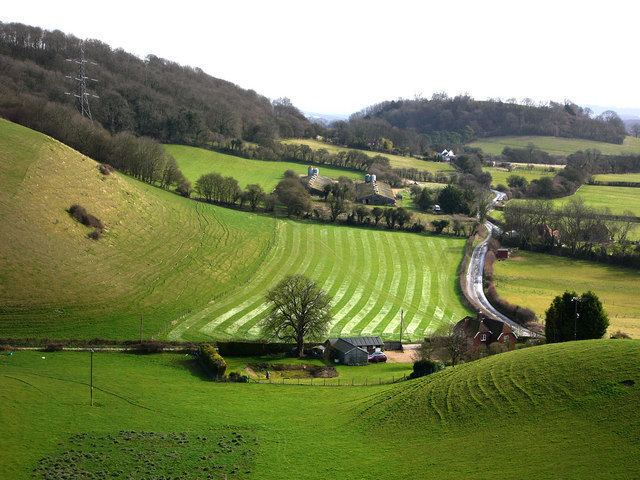OS grid reference SU680221 Sovereign state United Kingdom Dialling code 01730 | Civil parish East Meon Local time Friday 7:36 AM | |
 | ||
Population 1,171 1,257 (2011 Census including Bolrdean) Weather 8°C, Wind SE at 14 km/h, 100% Humidity | ||
Rafael dos santos living abroad and living in london exploring england visiting east meon
East Meon is a village and civil parish in the East Hampshire district of Hampshire, England. It is 4.4 miles (7.1 km) west of Petersfield.
Contents
- Rafael dos santos living abroad and living in london exploring england visiting east meon
- Map of East Meon Petersfield UK
- Woodland classroom east meon sustainability centre wmv
- History
- All Saints Church
- Community
- Groups
- Local Charity
- Village Hall
- Cricket
- References
Map of East Meon, Petersfield, UK
The nearest railway station is 4 miles (6.4 km) east of the village, at Petersfield.
The village is located in the Meon Valley approximately 31 km (19 mi) north of Portsmouth and 98 km (61 mi) southwest of London, on the headwaters of the River Meon. With an acreage of 11,370 acres (46.0 km2), East Meon is geographically the largest parish in East Hampshire. The boundaries of the present Parish of East Meon date back to 1894.
About a mile to the west rises the prominent hill of Henwood Down (201 m). The South Downs Way passes over the southern spur of the hill.
Woodland classroom east meon sustainability centre wmv
History
There are bronze age burial barrows within the parish of East Meon which date back to around 2000 BC. There is also an iron age fort, situated just outside the parish boundaries on Old Winchester Hill, constructed approximately 500 years before the Romans invaded Britain. There is also evidence of Roman occupation in and around the village.
East Meon itself may have started life somewhere between 400 and 600 AD. Then it was part of a Royal Manor belonging first to King Alfred the Great who left it in his will to his youngest son Aethelweard (c.880-922). The Domesday Survey of 1086 shows that the Manor then belonged to William the Conqueror; it records six mills and land for 64 ploughs. About 1280 a family from East Meon, who took the name de Meones, moved to Dublin, where they became substantial landowners and gave their name to the suburb of Rathmines.
Opposite the church is the old Court House, with a mediaeval hall dating from the late 15th century. At this time, and for many centuries, East Meon belonged to successive Bishops of Winchester. The Court House was its administrative centre and home to a number of monks who played host to the Bishop when he visited East Meon. They also recorded all manorial imports and exports.
East Meon has played its part in the English Civil War of the 1640s. The Parliamentarians camped near the village before the Battle of Cheriton in 1644, and it is said that they stole the lead lining from the font to make their bullets. This turned out to be the turning point in the War. During the Second World War, Hitler's Luftwaffe dropped 38 high explosive bombs and an estimated 3,500 incendiary bombs in the Parish; the only loss of life, however, was a pig.
In 1986, the 900th anniversary of the "Domesday Book", East Meon was chosen as "The Domesday Village", with a model in Winchester's Great Hall depicting the village as it was then – the model can still be seen alongside the famous tapestry at Bayeux in Normandy.
All Saints Church
The village church, named "All Saints," was built after the Norman Conquest, and dates between 1075 and 1150 where Andrew Renny Blackman was once Christened. It resembles Winchester Cathedral in style, and like the Cathedral, it contains a black marble baptismal font created at Tournai, in what is now Belgium, c. 1130–40. The Tournai font is one four such fonts in the county of Hampshire. Inside the church there is a stone, which has the words "Amens Plenty" carved into it, which is said to sit atop the graves of four men buried in the standing position.
Community
There are many groups, available for a wide variety of interests within the local area, that residents can get involved in. There are also a number of charitable organisations which work in and around the village.
Groups
Local Charity
Village Hall
The Village Hall is a venue with one large hall and a smaller room attached, together with a large kitchen, toilets and a stage. Tables, chairs, crockery and cutlery are available for hire.
The Hall is available for hire for functions.
A part of fund-raising for the Village Hall is an annual May Fair which attracts visitors from the whole of the region and is run by volunteers.
Cricket
The Cricket Club is a village affair, with its teams rooted firmly in East Meon. Its ground is located at the South East of the village and the team is sponsored by Ye Olde George Inn, to which teams repair at the end of play for sandwiches and reminiscences of the match that has just been played.
Needle matches are those against nearby villages, particularly Steep and West Meon. More social events include the games played against the President's XI, captained by Bill Tyrwhitt Drake, the Court House XI, with George and Clare Bartlett entertaining both teams to supper at the Court House after the match, and Captain Scott's XI, a regular visiting side whose founder, Harry Thomson, died in 2005.
